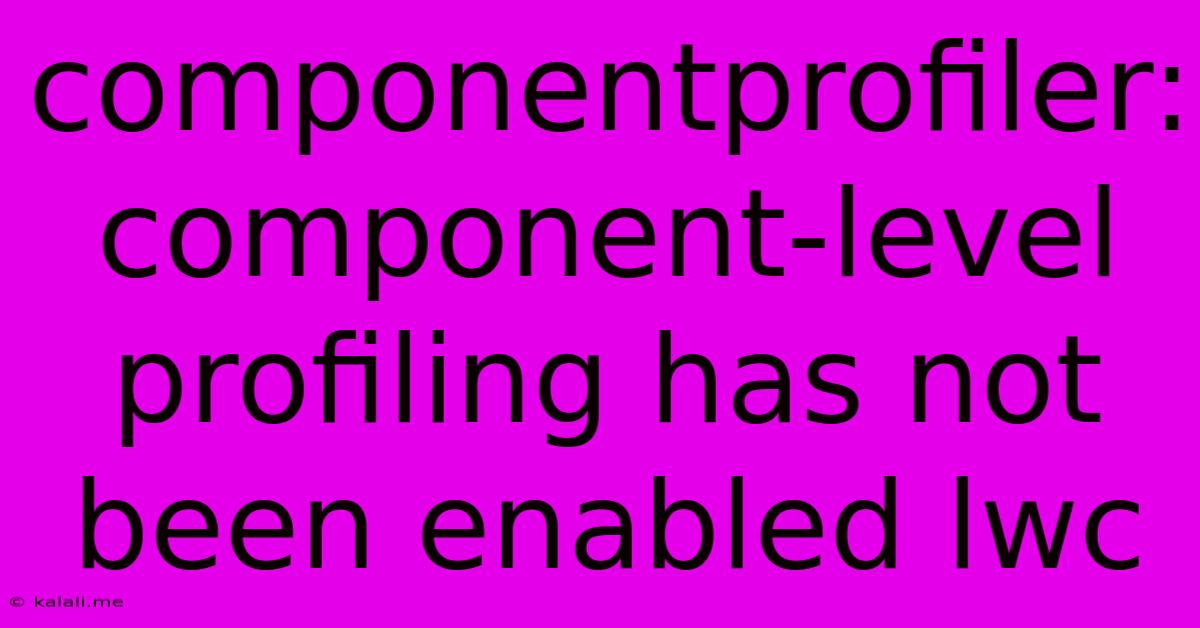Componentprofiler: Component-level Profiling Has Not Been Enabled Lwc
Kalali
May 23, 2025 · 3 min read

Table of Contents
ComponentProfiler: Resolving "Component-level profiling has not been enabled" in LWC
Are you encountering the frustrating "Component-level profiling has not been enabled" message while trying to use the ComponentProfiler in your Lightning Web Components (LWC)? This comprehensive guide will walk you through understanding the issue and implementing effective solutions. This message typically arises when the necessary configuration for enabling detailed performance analysis of individual LWC components is missing. We'll cover the troubleshooting steps, explore the benefits of component-level profiling, and provide best practices to prevent this issue in the future.
Understanding Component-Level Profiling in LWC
Component-level profiling is a crucial tool for optimizing the performance of your LWC applications. It allows you to pinpoint performance bottlenecks within individual components, enabling you to identify areas needing optimization. This granular level of analysis is invaluable for improving the rendering speed, responsiveness, and overall user experience of your application. Without it, you're essentially working blind when trying to improve performance. Knowing which components are causing slowdowns is the first step towards a faster, smoother application.
Why the "Component-level profiling has not been enabled" Error Occurs
The error message clearly states the problem: the necessary configuration flags haven't been set to allow the ComponentProfiler to function correctly. This often stems from incorrect configuration in your Salesforce org or a missing feature activation. This isn't a bug in your code, but rather a misconfiguration within the Salesforce environment.
Troubleshooting and Solutions
Let's address the most common causes and solutions for this issue:
1. Verify Salesforce Org Settings:
-
Feature Activation: Component-level profiling might require specific feature flags to be activated in your Salesforce org. Check your org's settings to ensure that the necessary features are enabled. This often involves accessing your Salesforce admin settings and searching for features related to Lightning Web Components or performance monitoring. The exact location may vary depending on your Salesforce edition and release.
-
User Permissions: Ensure that your user profile has the required permissions to access and utilize the profiling tools. Insufficient permissions can prevent access to profiling data, resulting in the error message. Check your user profile's permissions in the Salesforce admin settings.
2. Check Your Browser's Developer Console:
- Console Errors: Often, additional error messages or warnings might be present in your browser's developer console (typically accessed by pressing F12). These can provide valuable clues about the root cause of the issue, beyond the initial error message. Look for clues related to JavaScript errors or network requests that could be hindering the profiler's functionality.
3. Browser Compatibility and Cache:
- Supported Browsers: Confirm that you are using a supported browser. The ComponentProfiler might have compatibility limitations with certain older or unsupported browsers. Try clearing your browser's cache and cookies and then trying again. Testing in a different browser, like Chrome or Firefox, might also help isolate the problem.
4. Code Issues (Less Likely):
While less frequent, it's worth noting that some rare code issues could indirectly interfere with the profiler's ability to gather data. This usually manifests as other JavaScript errors or exceptions. Thoroughly review your LWC code for any potential errors or issues that could affect the component's rendering or lifecycle.
Best Practices for Preventing Future Issues
-
Regularly Check Org Settings: Make it a habit to periodically review your Salesforce org's settings, particularly regarding feature flags and user permissions, to ensure everything is correctly configured for performance monitoring.
-
Keep Browsers Updated: Using the latest versions of supported browsers helps minimize compatibility issues and ensures access to the latest performance analysis features.
-
Comprehensive Testing: Perform thorough testing across different browsers and devices to identify potential compatibility problems early in the development cycle.
Conclusion:
The "Component-level profiling has not been enabled" message in LWC is usually a configuration problem, not a coding error. By following the troubleshooting steps outlined above and adopting best practices, you can effectively resolve this issue and unlock the power of component-level profiling to optimize your LWC applications for peak performance. Remember to systematically check your Salesforce org settings, browser console, and browser compatibility for the most effective troubleshooting.
Latest Posts
Latest Posts
-
How Do I Send An Evite Reminder
Jul 15, 2025
-
When Performing A Self Rescue When Should You Swim To Shore
Jul 15, 2025
-
How Many Decaliters Are In A Liter
Jul 15, 2025
-
What Note Sits In The Middle Of The Grand Staff
Jul 15, 2025
-
Did Lynette Shave Her Head In Real Life
Jul 15, 2025
Related Post
Thank you for visiting our website which covers about Componentprofiler: Component-level Profiling Has Not Been Enabled Lwc . We hope the information provided has been useful to you. Feel free to contact us if you have any questions or need further assistance. See you next time and don't miss to bookmark.